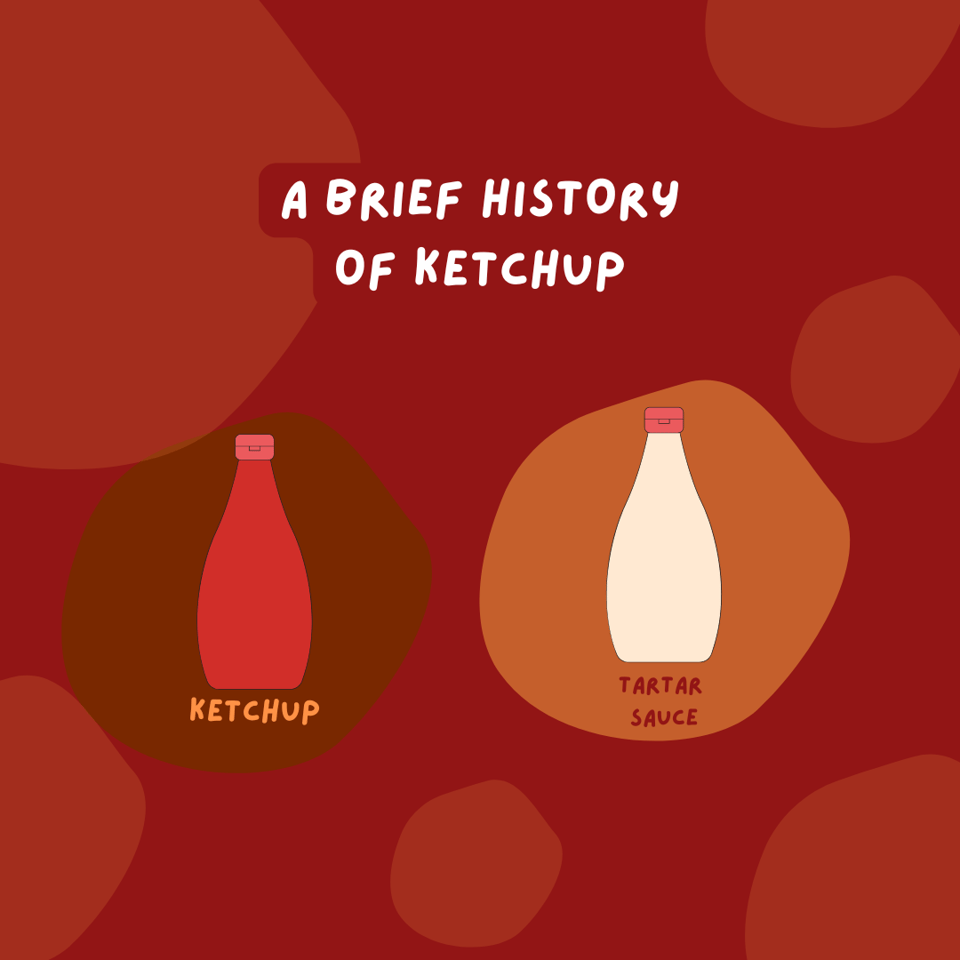The Brief History of Ketchup
A nice prequel to my hot dog article if I ever finish it!

Hi Bestie!!
Have you ever been asked a question and been so certain you knew the answer that you didn't care if everyone thought you were wrong? I don't usually have this level of confidence, but Monday I was casually confident in a way I'd like to feel every single day.
Here is the question from Monday night's Good Question Trivia, posted with some permission:
What word that's likely derived from a Chinese dialect term once used for "fish sauce" is still used to describe a condiment today — a condiment that came about in its final version in New England in the 1790s?
I was not part of my usual team (shout out to this team anyway) and I had, hilariously, suggested earlier in the evening that the co-star of Ace Ventura was "the monkey." (It was Courtney Cox.) It was the sort of light bulb agreement that was so incredibly wrong that it may be funny for the rest of my life. A Washington Post review called the film vulgar and it was banned from the house.
Anyway, I sat at the end of a table with a bunch of (kind) men I didn't know, with a basket of chicken tenders I had thought about since Labor Day, and said, "Oh, it's ketchup."
Our team wrote tartar sauce, thinking about cream of tartar, the Northeast, and the Silk Road.
Tartar sauce does not contain cream of tartar. The white condiment contains mayonnaise, chopped pickles and olives, capers, tarragon, and dill. It can also contain mustard, lemon juice, and other herbs. It's commonly served with fried seafood. I've watched my mom whip it up on a Sunday afternoon more than once. (She uses Durkee.)
Potassium bitartrate, cream of tartar, stabilizes egg whites and whipped cream, can be used as a thickener, prevent sugar syrups from crystallizing, reduces discoloration of boiled vegetables, is a component in baking powder, is a substitute for salt, adds volumes to cakes, and makes baked goods more tender. You need it to make snickerdoodles and my family's fairy dust cookies. You shouldn't add it to your mayonnaise sauce for steak and fried cod.
You could dip your fried fish in ketchup. I told a friend this story and she said, "Oh, of course. Fish sticks taste so good in ketchup!" You are so supportive, I thought, personally disgusted by fish sticks. You can do a lot with ketchup, and it was different in the 1700s in New England.
To start, it was made with mushrooms. It still is in the UK, and I don't know if I have ever been so repulsed by mushroom ketchup as I am now. I am typing and yacking at the same time. Mushroom ketchup is basically the same as ketchup, replacing mushrooms where we expect tomatoes. Ironic, because tomatoes were considered poisonous in the UK and the thirteen colonies, and, well, if you eat the wrong mushroom you're going to do a lot more than retch. Both were made with anchovies. For some, hell is pushing a boulder up a hill every day or having your liver pecked by vultures. For me, it's a hot dog slathered in a mushroom anchovy sauce.
Ketchup, as we know it, was eventually tomatoes, vinegar, salt, onions, allspice, coriander, cloves, cumin, garlic, mustard, celery, cinnamon, and ginger. Anchovies were discontinued in the 1850s. The word first appeared in print in 1682; the recipe was first printed in 1812. It appeared in a cookbook, The Virginia Housewife, in 1824. Heinz, which was famously introduced in 1876, advertised that it would save the American Housewife. (Gee, what hasn’t.)
The tomato soon became a fad (tomato pills, which didn't contain much tomato if any, were sold to cure pleurisy) and was praised for its health benefits. People began to make soup and eat it raw. Somewhere, 100 years later, someone sliced it and put it on a grilled cheese.
There are "competing theories" to how we came to ketchup. There are also some misunderstandings, mine, about tomatoes. I have self-corrections. Tomatoes arrived in the Americas by way of the Andes, where the plant grew wild. (I wonder what kind, what color, what size! This year I grew two types of yellow cherry tomatoes and mostly I ate them off the vine while I weeded and pruned.) The nightshade made its way North, through Central America and Mexico, before being cultivated in America.
Before tomatoes were brought to Italy by Spainards in the 1500s they collected seeds from Native Americans; the plant was called tomatl. Tomatoes were then cultivated in Europe, first in Spain, then everywhere else, even though Europeans had a real vine up their ass about tomatoes. (They are joined by Tom Brady, who has never eaten one.) In France, it was called a love apple; the French though it was an aphrodisiac. It was also called wolf peach, poison apple, and gold apple. (Europeans died because they were eating on pewter dinnerware.)
They brought tomatoes to Europe after infecting indigenous people in the Americas with whatever disease they happened to have at the time. (I'm so mad Tim Walz didn't better defend federal land, by the way!) It was a long road for the tomato in Italy, where it was compared to eggplant. The first sauce recipe was published in 1694. It was a "botanical curiosity" for the rich. BRB, I'm going to Fish Market to ruin a New Jersey resident's night.
I may never turn over a new leaf.
The tomato arrived in China through the Philippines or Macau in the 1500s. There it was called "foreign eggplant." It was also viewed with skepticism, but eventually it was added to cuisine. Tomato sauce in Cantonese is "ke zap." But in two dialects, "the brine of pickled fish or shellfish" is kôe-chiap / kê-chiap. In Indoensian and Malay cuisine, fermented savory sauce is "kecap." This includes a sauce meant for fish! (The tomatoes in the colonies? They sat in salt for three days!)

I have a best friend who loathes tomatoes. When we go out, she'll push hers onto my plate. You are welcome to do the same.
Are relish and mustard next?
Always your friend,
Katherine
Sources (MLA 9)
Buckley, Julia. "How This Fruit Became the Star of Italian Cooking." CNN, Cable News Network, 12 Mar. 2021, www.cnn.com/travel/article/tomato-italy-history/index.html.
"Good Question Trivia." Instagram, www.instagram.com/goodquestiontrivia/. Accessed 3 Oct. 2024.
"Heinz." Wikipedia, Wikimedia Foundation, 26 Sept. 2024, en.wikipedia.org/wiki/Heinz.
"A History of Tomatoes." The University of Vermont, www.uvm.edu/news/extension/history-tomatoes. Accessed 4 Oct. 2024.
"Ketchup." Wikipedia, Wikimedia Foundation, 2 Oct. 2024, en.wikipedia.org/wiki/Ketchup.
"Mushroom Ketchup." Wikipedia, Wikimedia Foundation, 15 May 2024, en.wikipedia.org/wiki/Mushroom_ketchup.
"Potassium Bitartrate." Wikipedia, Wikimedia Foundation, 17 Aug. 2024, en.wikipedia.org/wiki/Potassium_bitartrate.
Shropshire, Corilyn. "The History of Tomatoes in America." Cook’s Illustrated, Cook's Illustrated, 14 May 2021, www.americastestkitchen.com/cooksillustrated/articles/3244-history-of-tomatoes-in-america.
"Tom Brady Diet: TB12 Method Reviewed." Healthline, Healthline Media, www.healthline.com/nutrition/tom-brady-diet#:~:text=Tom%20Brady’s%20chef%20said%20in,aren'%20anti%2Dinflammatory. Accessed 4 Oct. 2024.